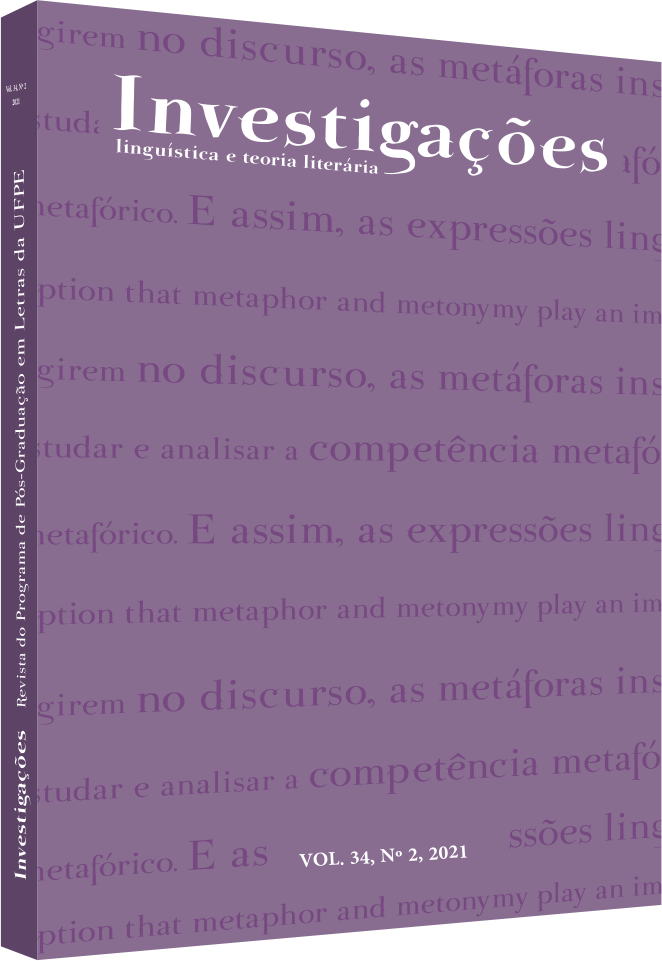O real e a metáfora: “mãozinhas” em discurso
DOI:
https://doi.org/10.51359/2175-294x.2021.251021Keywords:
discourse analysis, metaphor, real.Abstract
In this article, we discuss the theoretical constructions of Pêcheuxand other researchers regarding the meeting point between the real of language and the real of history. In the COVID-19 pandemic context, two nurses created the "mãozinhas do amor" technique.Withgloves with hot water, it simulates the touch of the humanhand next to the hand of the COVID-19 patient. We analyze how this technique points to the horror and the unnamable of death through metaphor.References
BARBAI, Marcos Aurelio; PACHECO, Ana Laura Prates. (2016). (H)A LÍNGUA. Línguas e Instrumentos Linguísticos, n. 38, p. 157-159.
COURTINE, J.-J. ([1981] 2009). Análise do discurso político: o discurso comunista endereçado aos cristãos. São Carlos: Edufscar.
GADET, F. (1978) La double faille. Actes du Colloque de Sociolinguistique de Rouen, Roen, p. 511-515.
GADET, F.; PÊCHEUX, M. ([1981] 2004) Língua inatingível: o discurso na história da linguística. Campinas: Unicamp.
HENRY, P. ([1977] 1992). A ferramenta Imperfeita: língua, sujeito e discurso. Campinas: Unicamp.
MILNER, J.-C. ([1978] 2012). O amor da língua. Campinas: Editora da Unicamp.
MODESTO, R.; ANJOS, L. (2017). Um social dividido, um não-lugar encenado pela fuga. Rua, n. 23, v. 1, p. 5-22.
PÊCHEUX, M. Análise automática do discurso (AAD69). In: GADET, F.; HAK, T. (Org.). Por uma análise automática do discurso: uma introdução à obra de Michel Pêcheux. 5. ed. Campinas: Unicamp, [1969] 2014.
PÊCHEUX, M. Delimitações, inversões, deslocamentos. Cadernos de estudos linguísticos, n. 19, p. 7-24, [1982] 1990.
PÊCHEUX, M. O discurso: estrutura ou acontecimento? Campinas: Pontes, [1983] 2008.
PÊCHEUX, M. Semântica e discurso: uma crítica à afirmação do óbvio. 2. ed. Campinas: Pontes, [1975] 1995.
PÊCHEUX, M. Só há causa daquilo que falha ou o inverno político francês: início de uma retificação. In: PÊCHEUX, M. Semântica e discurso: uma crítica à afirmação do óbvio. 2. ed. Campinas: Pontes, [1978] 1995.
PÊCHEUX, M. Prefácio. COURTINE, Jean-Jacques; MARADIN, Jean-Marie. Que objeto para a análise do discurso? In: CONEIN, B. et al. Materialidades Discursivas. Campinas: Editora da Unicamp, 2016.
SANTIAGO, S. A quarta-feira de cinzas da humanidade. In: Suplemento Pernambuco, 2020. Disponível em: http://suplementopernambuco.com.br/artigos/2460-a-quartafeira-de-cinzas-da-humanidade.html?fbclid=IwAR35oV3b6QznS8UEApXUaEiMhfCfo5IEI_i2cpcHdufRF0KPqO_Og9ag-E. Acesso em: 12/06/2021.
SOUSA, L. M. A. O real e a poesia nos entremeios litorâneos de Pêcheux e Lacan. Revista Fragmentum. Santa Maria, Universidade Federal de Santa Maria, 2016.
Downloads
Published
How to Cite
Issue
Section
License
Copyright (c) 2021 Lucília Maria Abrahão e Sousa, André Cavalcante, Thales de Medeiros Ribeiro

This work is licensed under a Creative Commons Attribution 4.0 International License.
Authors who publish with Revista Investigações agree to the following terms:
Authors retain copyright and grant the journal right of first publication with the work simultaneously licensed under the Creative Commons Attribution 4.0 International (CC BY 4.0) license that allows others to share the work with an acknowledgement of the work's authorship and initial publication in this journal.
Authors are able to enter into separate, additional contractual arrangements for the non-exclusive distribution of the journal's published version of the work (e.g., post it to an institutional repository or publish it in a book), with an acknowledgement of its initial publication in this journal.
You are free to:
Share — copy and redistribute the material in any medium or format for any purpose, even commercially.
Adapt — remix, transform, and build upon the material for any purpose, even commercially.
The licensor cannot revoke these freedoms as long as you follow the license terms.
Under the following terms:
Attribution — You must give appropriate credit , provide a link to the license, and indicate if changes were made . You may do so in any reasonable manner, but not in any way that suggests the licensor endorses you or your use.
No additional restrictions — You may not apply legal terms or technological measures that legally restrict others from doing anything the license permits.

